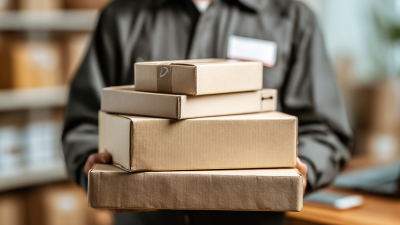In today's fast-paced e-commerce environment, efficiently shipping items has become a crucial aspect of maintaining customer satisfaction. With increasing expectations and demands from consumers, businesses are continuously seeking ways to streamline their shipping processes while ensuring that products arrive safely and on time. The shipping experience can significantly influence customer perceptions and loyalty, making it essential for companies to adopt strategies that enhance efficiency in shipping items.

By focusing on effective shipping practices, businesses not only improve their operational performance but also create positive experiences for their customers. From choosing the right carriers to optimizing packaging, each step in the shipping process plays a vital role in ensuring that items reach their destination without delays or damages.
The following tips will provide valuable insights for businesses aiming to maximize customer satisfaction through efficient shipping methods, ultimately paving the way for repeat business and a strong reputation in the competitive marketplace.
In the competitive landscape of e-commerce, selecting the right shipping method is crucial for enhancing delivery speed and ultimately boosting customer satisfaction. Customers now expect not only fast delivery but also transparency regarding shipping speeds. To meet these expectations, it is essential to clearly communicate estimated delivery times at the checkout. This practice not only builds consumer confidence but also helps to reduce cart abandonment, allowing businesses to convert more sales.
 One effective strategy for optimizing your shipping process is to incorporate same-day or next-day delivery options whenever feasible. As the last-mile delivery segment becomes increasingly vital, offering expedited shipping can significantly influence customer retention and brand loyalty. Additionally, leveraging analytics to evaluate shipping performance can provide insights into operational efficiencies, enabling businesses to choose carriers that best align with their delivery speed requirements without compromising cost-effectiveness.
One effective strategy for optimizing your shipping process is to incorporate same-day or next-day delivery options whenever feasible. As the last-mile delivery segment becomes increasingly vital, offering expedited shipping can significantly influence customer retention and brand loyalty. Additionally, leveraging analytics to evaluate shipping performance can provide insights into operational efficiencies, enabling businesses to choose carriers that best align with their delivery speed requirements without compromising cost-effectiveness.
Lastly, adopting a flexible shipping strategy that includes both standard and express options can cater to diverse customer preferences. Some customers may opt for cost-effective solutions, while others may prioritize speed. By offering a variety of shipping methods, businesses can enhance the overall customer experience and ensure that they meet the diverse needs of their clientele.
When it comes to shipping items, effective packaging is crucial for ensuring products arrive safely and in pristine condition. One fundamental technique is to select the right box size. Packaging items in boxes that are too large can lead to unnecessary movement during transit, increasing the risk of damage. Conversely, a snug fit helps reduce shifting, but care should be taken not to pack items too tightly, as this can cause stress on the contents.
Another essential technique is the use of appropriate cushioning materials. Bubble wrap, packing peanuts, or recycled paper can provide an effective barrier against shocks and impacts. Layering these materials not only protects fragile items but also absorbs vibrations that could occur during transportation. Furthermore, sealing the package securely with high-quality tape reinforces the box's integrity, preventing it from opening en route. By incorporating these essential packaging techniques, businesses can significantly reduce the likelihood of damage, leading to enhanced customer satisfaction and trust in their shipping practices.
| Tip | Description | Essential Packaging Technique | Expected Outcome |
|---|---|---|---|
| Choose Right Packaging Materials | Selecting materials suited for the product type can help prevent damage during transit. | Use bubble wrap, foam sheets, or air pillows for cushioning. | Reduced breakage and returns. |
| Label Packages Clearly | Clear labeling helps ensure proper handling and delivery. | Use waterproof and tear-proof labels. | Faster and more accurate deliveries. |
| Optimize Package Size | Minimize wasted space to reduce shipping costs and environmental impact. | Use custom-sized boxes or envelopes. | Cost-effective shipping. |
| Include Internal Padding | Adding padding inside the package can prevent items from shifting. | Use packing peanuts or shredded paper. | Enhanced protection for fragile items. |
| Test Your Packaging | Test how well your packaging protects items by conducting drop tests. | Simulate shipping conditions. | Improved reliability in shipping. |
To maximize customer satisfaction in shipping, leveraging technology to provide real-time tracking and updates is crucial. With the ability to offer customers live tracking links, businesses can keep recipients informed about their package’s journey, fostering trust and transparency. This not only alleviates anxiety but also enhances the overall shopping experience. When customers know exactly when to expect their orders, they are more likely to feel valued and content.
In addition to real-time tracking, integrating automated notifications can significantly improve customer engagement. Consider sending automated updates via email or SMS at key stages of the shipping process – from confirmation of shipment to delivery notification. This proactive approach ensures customers are always in the loop, which can lead to higher satisfaction ratings. Offering these updates demonstrates a commitment to customer service, giving clients peace of mind regarding their purchases.
Lastly, investing in customer-friendly technology can streamline the return and exchange process, making it smoother for everyone involved. By utilizing platforms that allow for easy returns tracking, businesses can further enhance the customer experience. Satisfied customers are likely to become repeat buyers, so employing these tech-driven solutions can result in lasting loyalty and enhanced brand reputation.
Effective communication is paramount in managing customer expectations during the shipping process. A report by Convey found that 83% of consumers expect regular updates on their orders, emphasizing the need for businesses to adopt proactive communication strategies. Utilizing automated notifications via email or SMS can keep customers informed about their order status, including shipping confirmations, tracking links, and delivery estimates. Clear communication not only enhances customer satisfaction but also reduces the volume of inquiries related to order status, allowing businesses to focus on other priorities.

Moreover, transparency regarding shipping timelines and potential delays is critical. According to a survey by Shopify, 61% of customers are willing to make a repeat purchase from a retailer that provides transparent information about shipping times, even if that means waiting longer for delivery. By clearly outlining shipping options and expected delivery windows on product pages, businesses can align customer expectations with operational realities, thereby fostering trust and loyalty. In an era where customer experience drives brand success, adopting best practices for communication can significantly elevate the overall shopping experience.
In today's competitive e-commerce landscape, incorporating flexible return policies can significantly enhance customer confidence and satisfaction. According to a report by the National Retail Federation, about 67% of consumers check a retailer's return policy before making a purchase. When customers know they can return items without hassle, they are more likely to complete their transactions, ultimately boosting conversion rates.
Additionally, a study conducted by Invesp found that 30% of online shoppers would think twice about purchasing from a retailer that does not offer a straightforward return process. Implementing a customer-friendly return policy not only alleviates purchasing anxiety but also fosters loyalty. Businesses that prioritize returns as a part of their logistics strategy can enjoy higher customer retention rates—up to 30% according to research from Locus.
Moreover, providing options such as free returns or extended return windows not only demonstrates a retailer's commitment to customer satisfaction but can also minimize lost sales. Consumers increasingly value their shopping experience, and the ability to return items flexibly can turn a one-time buyer into a loyal repeat customer, influencing future purchasing decisions.






Get Free Estimate!

